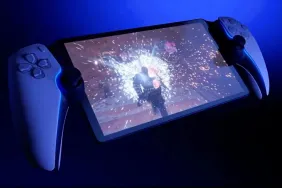You know that pro athlete who’s a real dynamo in the minor leagues, but only stays up with the big club for about a quarter of the season, cumulatively? Make that guy a video game, and he’s Sumioni. As a smartphone or tablet game, this would be some good stuff, but next to the Vita’s launch window, it’s hard to recommend this.
Players control Agura, a demon who uses ink as his primary weapon. They can paint the screen with their swipes, then Agura can jump onto the temporary platforms that have been created for him. Melee attacks are available, but there’s sometimes a strategic approach that must be taken in order to get Agura in the right spot to land a hit. That’s where all this line painting comes in. Beating a foe is not so much a matter of getting in front of him and whacking him in the face (though sometimes it is), it’s more often a matter of drawing the lines on the screen, hopping onto your self-made platforms, then hitting the bad guy in the face. This is all fun at first, but even before the half-hour mark, around which you’ll be getting the first ending, the flavor starts to disappear. Even a few varieties of attacks, the presence of summon spells, and the ability to straight up light things on fire at almost any moment — something all of us have always wanted to do — can’t keep things spicy for long.
With 30 stages, it may initially sound as if there is a good amount of lasting value in Sumioni, but numbers are misleading. A lot of players will be playing in the first few over and over and over again, not really knowing if they’re even doing the right thing to move on. Worse, no explanation is given. It’s not the gameplay that’s frustrating, it’s this lack of involvement by the developers — this poor presentation, this inefficient setup — that causes stress in Sumioni. Knowing how easily this problem could have been avoided just adds to the anger. To not know why you’re doing something repetitive is frustrating, and it’s one reason Sumioni is overall lacking.
While it undeniably feels more like a phone game than something that belongs on a dedicated gaming device, Sumioni‘s controls would probably be unwieldy without the inclusion of both buttons and a touchscreen. That’s sad because it makes hope for a $10 iPhone port unlikely, meaning the game may never appear on the platform with a price that fits it best. Both touching and jumping can be done with either buttons or a careful touch of the screen, but the buttons seem the most reliable and natural method. They’re not without flaw, however, as players who prefer the stick will be making a lot of accidental jumps.

The problem with the platforming is that it, like other aspects of the game, loses its fun too quickly. Those first 10 or 15 or 68 times being faced with an obstacle, then painting a line in order to get over it, are a good helping of innovative fun. The same can be said of the boss fights. Many enemies look different and have varying attacks, but nearly all require the same general tactics to defeat. The experience feels hollow — such a flashy exterior with so little delivery.
The strongest aspect of Sumioni is its visuals — a sad statement for a platforming action game. It’s not graphically impressive so much as it has an art style not often seen in games. It looks remarkably similar to actual paintings from old Japan, and even the player’s strokes across the screen look like those of a real Japanese calligraphy brush. One can tell that these aesthetics are exactly what developer Acquire was going for, as they definitely succeed at being a fictional homage to something real.
Great artwork sadly can’t lift the game very much, however, and the game as a whole still feels unworthy of much money or time. On that note, props to XSeed for at least having the decency to price the game at half the usual cost of Vita software, keeping the size and value of the game in mind. The industry needs more honesty like that. Hopefully other publishers take note that not every game should be $40. Working against it is the fact that physical media fans might be sad to learn that the game can only be downloaded via PSN; you won’t find this one in stores.
Sumioni blends good visuals and music with some innovative play, but innovation doesn’t automatically grant quality. While its first moments are impressive and show off neat ideas, there isn’t enough to the formula to call it complete as is. It gets old, repetitive and unsatisfying in short order. Playing it lost all fun after an hour. Maybe there are people out there who might like this game, but I’m not one of them. There are things to like about it, but as a whole package, Sumioni falls short of expectations.
PlayStation LifeStyle’s Final Score
+ Great art style and innovative gameplay. – Extremely short. +/- Fun and different at first, but fades out very quickly. |
 |








